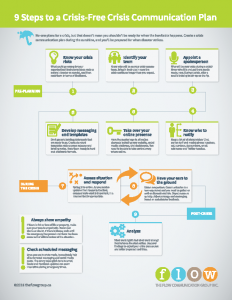Spoiler: The first six steps take place before the crisis happens
No one ever wants a crisis. By their very nature they are unpredictable, frightening, and can sometimes come with loss of property and/or life. They can happen at any time and last anywhere from a few hours to months or more.
But because a crisis can happen with little or no warning, it’s best to plan now. Both public and private sector organizations should have a crisis communication plan ready to go.

A crisis is defined as a period of intense trouble, difficulty, or danger, and is expected to lead to a dangerous situation such as an emergency or disaster. Communication pros know to get ahead of an emergency or disaster by implementing their crisis plan before a disaster strikes, though sometimes that
So what does a crisis communication plan look like? Its complexity is scaled in comparison to the size of your corporation or region. Known risks will also have an impact on your plan’s size. That said, most plans will contain the same general content:
PRE-CRISIS
- Know your crisis risks
What could go wrong for your organization? Brainstorm ideas, and then rank them in terms of likelihood. Crises can range from natural disaster, terrorism, a scandal involving organization officials, workplace violence, or rumours that impact an organization’s reputation.
- Identify your communication team
Most organizations have dedicated communication staff, or a contracted consultant or agency. These people will likely form your crisis communication team. If an emergency is short lived, existing manpower is easily deployed to attend to the crisis. But if a crisis lasts many days or weeks, make sure you know who you can call: Identify other team members, either from within your organization or additional consultants you can call in on a moment’s notice.
- Identify and train spokespersons
Who will be the voice of your organization during an emergency? Your spokesperson should be from the right role (the higher up the better), have the right training, and have the right skills.
Media training should be part of your corporate communication plan. Senior executives, and elected officials or board members should all receive some level of media training so they understand the basics of key messages, bridging strategies, and know what to expect when reporters call. During a crisis, your spokesperson may need a quick refresher lesson on speaking to the media.
- Know whom to notify
Keep an updated list of everyone you should communicate with during an emergency. Gather phone numbers, cell numbers, fax numbers and email addresses for ALL your stakeholders. This includes senior staff, elected or board members, local and regional media (reporters, producers, news desks), and any other stakeholders that you may need to communicate directly with. Also ensure you have a system to communicate with employees.
- Get the master keys to your online world
Ensure you have the ability to drive your online bus. This includes passwords and publishing access to your corporate website, as well as logon credentials to all social media platforms. In an emergency, you need to be able to publish updates and respond to comments on all channels.
During a crisis, disable any pending social media posts and email blasts you may have scheduled. It can look incredibly insensitive if your Facebook channel posts about an upcoming event or sale when everything is going sideways.
- Develop messaging and templates
Have holding statements ready to go. Holding statements acknowledge a situation before many details are known, but give the public the confidence you are on the ball. An example can be as simple as:
“Our thoughts are with the many people affected by this event. We will have more information as soon as we better understand the situation. Stay tuned for updates.”
Develop templates of common communication tactics, both online and in paper form (in case your power or network goes offline): press release, key messages, social media posts, etc.
A note about tone: If people’s lives or property is at risk, it is imperative to be empathetic. Never cast blame or doubt. Empathy in no way implies culpability, though you may have an internal disagreement on this with your legal counsel. If blame is to be directed, let that take place once the emergency has passed, and there has been some sort of official review of the situation.
DURING THE CRISIS
- Assess the situation and respond accordingly
As you receive new information and updates from both your team and operational team members, analyze and communicate what is most important. If you’ve prepared your plan in advance, this will be the first step once a crisis erupts.
Prepare key messages, press releases, updates and briefing notes, and continue as more information becomes available or as the situation evolves.
- Have your ears to the ground
Listen everywhere. Communication is a two-way street and you need to gather as well as disseminate information. Monitor what is being said and be quick to dispel any rumours or misinformation. Likewise, listen to stakeholders and use feedback to adjust any messaging or strategies.
Repeat Steps 7 and 8 until the crisis has passed.
POST-CRISIS
- Analyze
What went wrong? What went right? Once the situation is over and your team has had a rest, formally debrief your response. Use your findings to adjust the crisis communication plan so you are that much more prepared for the next time.
Remember: It CAN happen to you. Be prepared and have a crisis communication plan developed before you need it.
Download our handy crisis communication planning chart in PDF format.
We can help you develop your crisis communication plan. Get in touch.

